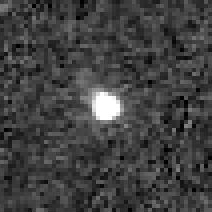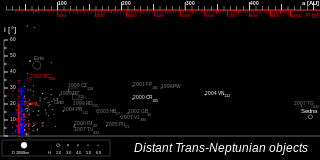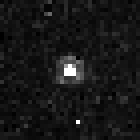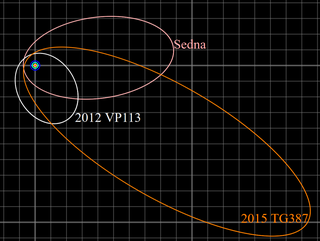
A trans-Neptunian object (TNO), also written transneptunian object, is any minor planet in the Solar System that orbits the Sun at a greater average distance than Neptune, which has an orbital semi-major axis of 30.1 astronomical units (au).

The scattered disc (or scattered disk) is a distant circumstellar disc in the Solar System that is sparsely populated by icy small Solar System bodies, which are a subset of the broader family of trans-Neptunian objects. The scattered-disc objects (SDOs) have orbital eccentricities ranging as high as 0.8, inclinations as high as 40°, and perihelia greater than 30 astronomical units (4.5×109 km; 2.8×109 mi). These extreme orbits are thought to be the result of gravitational "scattering" by the gas giants, and the objects continue to be subject to perturbation by the planet Neptune.

(612911) 2004 XR190, nicknamed Buffy, is a trans-Neptunian object, classified as both a scattered disc object and a detached object, located in the outermost region of the Solar System. It was first observed on 11 December 2004, by astronomers with the Canada–France Ecliptic Plane Survey at the Mauna Kea Observatories, Hawaii, United States. It is the largest known highly inclined (> 45°) object. With a perihelion of 51 AU, it belongs to a small and poorly understood group of very distant objects with moderate eccentricities.
(35671) 1998 SN165, prov. designation: 1998 SN165, is a trans-Neptunian object from the Kuiper belt located in the outermost region of the Solar System. It was discovered on 23 September 1998, by American astronomer Arianna Gleason at the Kitt Peak National Observatory near Tucson, Arizona. The cold classical Kuiper belt object is a dwarf planet candidate, as it measures approximately 400 kilometers (250 miles) in diameter. It has a grey-blue color (BB) and a rotation period of 8.8 hours. As of 2021, it has not been named.

(40314) 1999 KR16 is a trans-Neptunian object on an eccentric orbit in the outermost region of the Solar System, approximately 254 kilometers (158 miles) in diameter. It was discovered on 16 May 1999, by French astronomer Audrey Delsanti and Oliver Hainaut at ESO's La Silla Observatory in northern Chile. The very reddish object is a dwarf planet candidate and has a rotation period of 11.7 hours.
474640 Alicanto, provisionally designated 2004 VN112, is a detached extreme trans-Neptunian object. It was discovered on 6 November 2004, by American astronomer Andrew C. Becker at Cerro Tololo Inter-American Observatory in Chile. It never gets closer than 47 AU from the Sun (near the outer edge of the main Kuiper belt) and averages more than 300 AU from the Sun. Its large eccentricity strongly suggests that it was gravitationally scattered onto its current orbit. Because it is, like all detached objects, outside the current gravitational influence of Neptune, how it came to have this orbit cannot yet be explained. It was named after Alicanto, a nocturnal bird in Chilean mythology.

Detached objects are a dynamical class of minor planets in the outer reaches of the Solar System and belong to the broader family of trans-Neptunian objects (TNOs). These objects have orbits whose points of closest approach to the Sun (perihelion) are sufficiently distant from the gravitational influence of Neptune that they are only moderately affected by Neptune and the other known planets: This makes them appear to be "detached" from the rest of the Solar System, except for their attraction to the Sun.

(612584) 2003 QX113 is a large trans-Neptunian object from the scattered disc located in the outermost region of the Solar System. It is one of the most distant objects from the Sun at 60.5 AU. It was discovered by astronomers with the Canada–France Ecliptic Plane Survey at Mauna Kea Observatories, Hawaii, when it was near aphelion on 31 August 2003. It was provisionally designated 2003 QX113.

(82075) 2000 YW134, provisional designation: 2000 YW134, is a resonant trans-Neptunian object and binary system, located in the outermost region of the Solar System. It was discovered on 26 December 2000, by astronomers with the Spacewatch survey at Kitt Peak Observatory near Tucson, Arizona. The reddish object stays in a rare 3:8 resonance with Neptune. A smaller companion was discovered by the Hubble Space Telescope in October 2002. As of 2021, neither the primary body nor its satellite have been named.
(589683) 2010 RF43, provisionally designated: 2010 RF43, is a large trans-Neptunian object orbiting in the scattered disc in the outermost regions of the Solar System. The object was discovered on 9 September 2010, by American astronomers David Rabinowitz, Megan Schwamb and Suzanne Tourtellotte at ESO's La Silla Observatory in northern Chile.

A sednoid is a trans-Neptunian object with a perihelion well beyond the Kuiper cliff at 47.8 AU. Only four objects are known from this population: 90377 Sedna, 2012 VP113, 541132 Leleākūhonua (2015 TG387), and 2021 RR205, but it is suspected that there are many more. All four have perihelia greater than 55 AU. These objects lie outside an apparently nearly empty gap in the Solar System and have no significant interaction with the planets. They are usually grouped with the detached objects. Some astronomers consider the sednoids to be inner Oort cloud objects (OCOs), though the inner Oort cloud, or Hills cloud, was originally predicted to lie beyond 2,000 AU, beyond the aphelia of the four known sednoids.
(533560) 2014 JM80, provisional designation 2014 JM80, is a trans-Neptunian object from the scattered disc in the outermost Solar System, approximately 340 kilometers (210 miles) in diameter. It was discovered on 9 May 2010 by astronomers with the Pan-STARRS-1 survey at the Haleakala Observatory, Hawaii, in the United States. According to American astronomer Michael Brown, it is "possibly" a dwarf planet.
2014 FZ71 is a trans-Neptunian object, a scattered disc classified as a scattered and detached object, located in the outermost region of the Solar System. It was first observed on 24 March 2014, by a team led by American astronomer Scott Sheppard at the Cerro Tololo Inter-American Observatory in Chile. With its perihelion of almost 56 AU, it belongs to a small and poorly understood group of very distant objects with moderate eccentricities. The object is not a dwarf planet candidate as it only measures approximately 150 kilometers (93 miles) in diameter.
2015 FJ345 is a trans-Neptunian object and detached object, located in the scattered disc, the outermost region of the Solar System. It was first observed on 17 March 2015, by a team led by American astronomer Scott Sheppard at the Mauna Kea Observatories, in Hawaii, United States. With its perihelion of almost 51 AU, it belongs to a small and poorly understood group of very distant objects with moderate eccentricities. The object is not a dwarf planet candidate as it only measures approximately 120 kilometers (75 miles) in diameter.
2015 KQ174 is a trans-Neptunian object, both considered a scattered and detached object, located in the outermost region of the Solar System. The object with a moderately inclined and eccentric orbit measures approximately 154 kilometers (96 miles) in diameter. It was first observed on 24 May 2015, by astronomers at the Mauna Kea Observatories in Hawaii, United States.
(523635) 2010 DN93, provisional designation 2010 DN93, is a trans-Neptunian object from in the scattered disc located in the outermost region of the Solar System. It was discovered on 26 February 2010, by astronomers with the Pan-STARRS survey at Haleakala Observatory on the island of Maui, Hawaii, in the United States. Assuming a low albedo, the object is estimated at approximately 490 kilometers (300 miles) in diameter. It was numbered in 2018 and remains unnamed.

2013 FQ28 is a trans-Neptunian object, both considered a scattered and detached object, located in the outermost region of the Solar System. It was first observed on 17 March 2013, by a team of astronomers at the Cerro Tololo Inter-American Observatory in Chile. It orbits the Sun in a moderate inclined, moderate-eccentricity orbit. The weak dwarf planet candidate measures approximately 260 kilometers (160 miles) in diameter.
2013 SK100 is a trans-Neptunian object, both considered a scattered and detached object, located in the outermost region of the Solar System. The object with a moderately inclined and eccentric orbit measures approximately 135 kilometers (84 miles) in diameter. It was first observed on 29 September 2013, by astronomers at the Mauna Kea Observatories in Hawaii, United States.
2014 ST373 (prov. designation:2014 ST373) is a trans-Neptunian object and a detached object from the outermost region of the Solar System. With a perihelion of 50.2 AU, it belongs to the top 10 minor planets with the highest known perihelia of the Solar System. and is neither a scattered disc nor an extreme trans-Neptunian object. It measures approximately 370 kilometers (230 miles) in diameter and was first observed on 25 September 2014, by astronomers using the Dark Energy Camera (DECam) at Cerro Tololo Inter-American Observatory in Chile.









